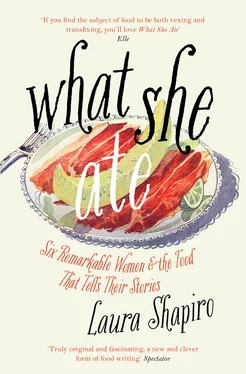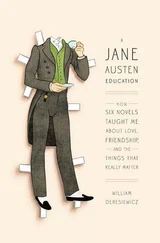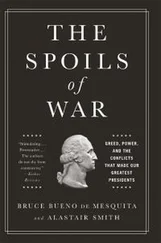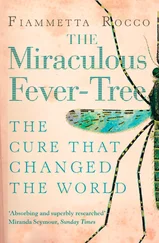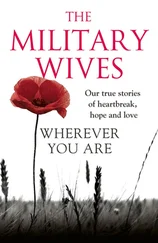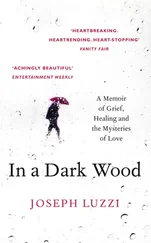It’s easy, it’s practically automatic, to associate cooking and eating with our warmest emotions, and to keep that image on permanent pause, with a family forever beaming as Norman Rockwell carries the turkey to the table. Perhaps there are women whose food stories really do land them in such a cozy domestic category. To me it seems more likely that we’re just not accustomed to scrutinizing the food as vigorously as we scrutinize a woman’s education, or her marriage, or the poetry she writes. What I saw on the surface of each woman’s culinary life was never the whole picture. Digging deeper into her food story took me to a more tenuous emotional realm—sometimes I thought of it as the underside of the Rockwell painting—where all those feelings that we’re trying not to notice start dribbling down the sides of the bowls and crawling out from under the platters. I don’t mean to imply that these women were unhappy; they weren’t. By most measures they experienced quite a bit of contentment and success. But in every instance, opening a window on what she cooked and ate cast a different light on the usual narrative of her life. It turns out that our food stories don’t always honor what’s smartest and most dignified about us. More often they go straight to what’s neediest.
Every life has a food story, and every food story is unique. As we move from chapter to chapter in this book, however, we’ll find that the themes emerging from each woman’s relationship with food not only reflect her own moment, but reach into ours as well. Dorothy Wordsworth, for instance, who starts off the book, appears at first to be something of an outlier, for she was born in the late eighteenth century—so much earlier than the other women that they would have regarded her culinary world as impossibly primitive. But apart from her spelling and capitalization, which of course reflected habits of her time, I found nothing old-fashioned about her descriptions of the meals she shared with William. It’s true, she practically ignored the flavor and texture of the food itself, which no food writer today would dream of doing. This is far from the heavy-breathing school of culinary reportage. But the mere presence of William at the table, sometimes lost in poetry as he sat there, was enough to send a wave of ecstasy through her account of the meal. “While we were at Breakfast that is (for I had Breakfasted) he, with his Basin of Broth before him untouched & a little plate of Bread & butter he wrote the Poem to a Butterfly!” she scrawled in her diary, so excited she lost track of the pronouns. “He ate not a morsel,” she added, “nor put on his stockings but sate with his shirt neck unbuttoned, & his waistcoat open while he did it.” Later in life, too, she exposed her appetites more nakedly than anyone else in this book, at least until we reach Helen Gurley Brown, whose prose also radiated adoration for a man but gave it rather a different spin.
The next chapter introduces Rosa Lewis, the British caterer and social striver, and a food story riddled with the pressures of class. Cooking and eating are always ruled by a tangle of social and economic realities that define a woman’s place in her particular world, and in Rosa’s time the class implications lodged even in a sandwich could be formidable. According to a food column in The New York Times in 1894, only a “day laborer” should be eating a sandwich made from thick slices of bread and stuffed with hefty chunks of meat. For ladies, an appropriate sandwich would measure no more than half an inch, “and its flavoring or filling is delicate and dainty, a suggestion rather than a substantial reality.” Nuances like these made sense to Rosa, who grew up in the servant class but escaped it by mastering the rarefied cuisine demanded by her rich and titled clients. White grapes and truffles went into her champagne ices, she told an interviewer; and she used to forage the markets for young, tender vegetables—“What you call ‘premier,’” she said, or at least that’s how the word was transcribed in the interview. In truth she was using the French term for those baby vegetables— primeurs —but the difference had been swallowed up in her brash Cockney accent. These were complicated jousts: the food could climb the social ladder, but sometimes the cook was left behind.
Eleanor Roosevelt comes next, with a food story dominated by her marriage—like class, a persistent theme in women’s relationships with food, though clearly Eleanor’s marriage was public to a degree that most couples don’t have to endure. She and FDR built what many historians have described as a grand political partnership, but it was also a union marked by culinary discords that reverberated into every corner of Eleanor’s life. Numerous references to their meals are scattered throughout the voluminous Roosevelt papers, and none speak well for the power of food to bring two hearts together. So far apart were their appetites that when FDR relaxed with a cocktail and a few smoked clams at the end of the day—a ritual he cherished—Eleanor often stayed away. She rarely touched alcohol, and the idea of spending money on a luxury like tinned clams, especially during the Depression, appalled her. George Eliot once remarked that men seemed to get a great deal of pleasure from the “dog-like attachment” of their wives, but this was not Eleanor’s approach to marriage. “He might have been happier with a wife who was completely uncritical,” she admitted. On many nights, dinner in the White House was served in two different rooms.
Eva Braun’s food story, generated as it was by her devotion to Adolf Hitler, might appear to take place strictly within an appalling realm of its own; and to an extent, it does. But despite the moral distance that separates her from everyone else in this collection, there are elements in her relationship with food that we’ve seen in other chapters. Like Dorothy, she always had her gaze fixed on the man she loved. Like Rosa, she was thrilled by her access to a higher social rank. What emerges most vividly in Eva’s relationship with food, however, is her powerful commitment to fantasy. She was swathed in it, eating and drinking at Hitler’s table in a perpetual enactment of her own daydreams. For propaganda reasons, she was not allowed to appear in public with Hitler, which meant that she had no truly gratifying forum in which to show herself off as the Führer’s chief consort. Only the lunches and dinners he took with members of his immediate circle allowed her to bask in a role for which she had trained by studying movie and fashion magazines. At these meals, her glory visible and her status secure, she treated food as a kind of servant whose most important job was to keep her thin. Indeed, the only aspect of Hitler’s life that she found repulsive was his heavy vegetarian diet. When the mashed potatoes with cheese and linseed oil came around, Eva said a firm no.
After Eva, you may be relieved to move on to Barbara Pym—I certainly was—and the warm, jovial relationship with food that she carried on all her life. “Today finished my 4th novel,” she wrote in her diary in 1954. “Typed from 10:30 a.m. to 3:30 p.m. sustained by in the following order, a cup of milky Nescafe, a gin and french, cold beef, baked potato, tomato-grated cheese, rice pudding and plums.” No, it’s not gastronomy. This is friendship. Food was a steadfast companion that nourished everything in Barbara, especially her creativity. If she so much as glimpsed a well-dressed woman in a café eagerly pouring ketchup over a plate of fish and chips, she came away with a character, then a plot, then a novel. Barbara was aware that modern fiction demanded heroines who were having passionate, tormented affairs, not ordering more pots of tea, but she couldn’t help herself. All she knew how to do was turn out brilliantly witty novels in her unique style, and when critics lost interest in her books, she just kept going. Barbara loved food and she loved love, and most of all she loved the connection between them, which was writing.
Читать дальше
